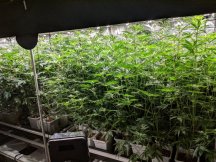-
CHUCKERSPARADISE NEWS: Click HERE to read.
#Heisenbeans Genetics
- Thread starter Heisen
- Start date
SoLowDoughLow
Mediocre grower
Me too, I have met nothing but helpful, generous, knowledgeable people here. If u get trolled or banned here it's usually because you're causing dramaAll Fire no Drama...That the way I like it. And bud shots lots of bud shots.
Everyone...even me..all growing Frosty Fire... And giving and getting help along the way.
And other awesome breeders sharing pics and info.
I love this forum.
spyralout
🌱🌿🌲🔥💨
Thanks Lubda. Helps with some decisions I gotta make soonThis phenotype and another stretched like crazy, I ended up tying them both down to help even out the canopy. The nose on both is super sweet/ sour candy.
BigBallzWillie
BE THE BALL
Not preachin....but..do you really want that in your tent?ROFL. That was hilarious. Bubba Katsu got the boot and those hot shot no pest strips are the shit. Lookin real good Heisen.
Those hot shot strips are poison, and continually dispensing into your grow.
...Dichlorvos is one of a class of insecticides referred to as organophosphates. These chemicals act by interfering with the activities of cholinesterase, an enzyme that is essential for the proper working of the nervous systems of both humans and insects. Please refer to the Toxicology Information Brief on cholinesterase-inhibition for a more detailed description of this topic....
...
Dichlorvos is highly toxic by inhalation, dermal absorption and ingestion (9). Because dichlorvos is volatile, inhalation is the most common route of exposure. As with all organophosphates, dichlorvos is readily absorbed through the skin. Skin which has come in contact with this material should be washed immediately with soap and water and all contaminated clothing should be removed.
Acute illness from dichlorvos is limited to the effects of cholinesterase inhibition. Compared to poisoning by other organophosphates, dichlorvos causes a more rapid onset of symptoms, which is often followed by a similarly rapid recovery (3). This occurs because dichlorvos is rapidly metabolized and eliminated from the body. Persons with reduced pulmonary (lung) function, convulsive disorders, liver disorders, or recent exposure to cholinesterase inhibitors will be at increased risk from exposure to dichlorvos. Alcoholic beverages may enhance the toxic effects of dichlorvos. High environmental temperatures or exposure of dichlorvos to visible or UV light may enhance its toxicity (9)....
...
The organophosphate insecticides are cholinesterase inhibitors. They are highly toxic by all routes of exposure. When inhaled, the first effects are usually respiratory and may include bloody or runny nose, coughing, chest discomfort, difficult or short breath, and wheezing due to constriction or excess fluid in the bronchial tubes. Skin contact with organophosphates may cause localized sweating and involuntary muscle contractions. Eye contact will cause pain, bleeding, tears, pupil constriction, and blurred vision. Following exposure by any route, other systemic effects may begin within a few minutes or be delayed for up to 12 hours. These may include pallor, nausea, vomiting, diarrhea, abdominal cramps, headache, dizziness, eye pain, blurred vision, constriction or dilation of the eye pupils, tears, salivation, sweating, and confusion. Severe poisoning will affect the central nervous system, producing incoordination, slurred speech, loss of reflexes, weakness, fatigue, involuntary muscle contractions, twitching, tremors of the tongue or eyelids, and eventually paralysis of the body extremities and the respiratory muscles. In severe cases there may also be involuntary defecation or urination, psychosis, irregular heart beats, unconsciousness, convulsions and coma. Death may be caused by respiratory failure or cardiac arrest (9).
Some organophosphates may cause delayed symptoms beginning 1 to 4 weeks after an acute exposure which may or may not have produced immediate symptoms. In such cases, numbness, tingling, weakness and cramping may appear in the lower limbs and progress to incoordination and paralysis. Improvement may occur over months or years, but some residual impairment will remain (9).
pleasecheese
Really Active Member
Man after reading all that i better go get a check up. lol.. seriously though i have used them in the past and they have helped a couple times when other things wouldnt. I kept mine in a ziplock slightly open for that very reason. I grow differently now and rarely have issues with bugs. what helped a lot was filling bottom of pots with lava rock before adding medium. Also neem/karanja cake mix added to a good living soil.Not preachin....but..do you really want that in your tent?
Those hot shot strips are poison, and continually dispensing into your grow.
...Dichlorvos is one of a class of insecticides referred to as organophosphates. These chemicals act by interfering with the activities of cholinesterase, an enzyme that is essential for the proper working of the nervous systems of both humans and insects. Please refer to the Toxicology Information Brief on cholinesterase-inhibition for a more detailed description of this topic....
...
Dichlorvos is highly toxic by inhalation, dermal absorption and ingestion (9). Because dichlorvos is volatile, inhalation is the most common route of exposure. As with all organophosphates, dichlorvos is readily absorbed through the skin. Skin which has come in contact with this material should be washed immediately with soap and water and all contaminated clothing should be removed.
Acute illness from dichlorvos is limited to the effects of cholinesterase inhibition. Compared to poisoning by other organophosphates, dichlorvos causes a more rapid onset of symptoms, which is often followed by a similarly rapid recovery (3). This occurs because dichlorvos is rapidly metabolized and eliminated from the body. Persons with reduced pulmonary (lung) function, convulsive disorders, liver disorders, or recent exposure to cholinesterase inhibitors will be at increased risk from exposure to dichlorvos. Alcoholic beverages may enhance the toxic effects of dichlorvos. High environmental temperatures or exposure of dichlorvos to visible or UV light may enhance its toxicity (9)....
...
The organophosphate insecticides are cholinesterase inhibitors. They are highly toxic by all routes of exposure. When inhaled, the first effects are usually respiratory and may include bloody or runny nose, coughing, chest discomfort, difficult or short breath, and wheezing due to constriction or excess fluid in the bronchial tubes. Skin contact with organophosphates may cause localized sweating and involuntary muscle contractions. Eye contact will cause pain, bleeding, tears, pupil constriction, and blurred vision. Following exposure by any route, other systemic effects may begin within a few minutes or be delayed for up to 12 hours. These may include pallor, nausea, vomiting, diarrhea, abdominal cramps, headache, dizziness, eye pain, blurred vision, constriction or dilation of the eye pupils, tears, salivation, sweating, and confusion. Severe poisoning will affect the central nervous system, producing incoordination, slurred speech, loss of reflexes, weakness, fatigue, involuntary muscle contractions, twitching, tremors of the tongue or eyelids, and eventually paralysis of the body extremities and the respiratory muscles. In severe cases there may also be involuntary defecation or urination, psychosis, irregular heart beats, unconsciousness, convulsions and coma. Death may be caused by respiratory failure or cardiac arrest (9).
Some organophosphates may cause delayed symptoms beginning 1 to 4 weeks after an acute exposure which may or may not have produced immediate symptoms. In such cases, numbness, tingling, weakness and cramping may appear in the lower limbs and progress to incoordination and paralysis. Improvement may occur over months or years, but some residual impairment will remain (9).
Heathenraider
Heathen Basterd
I just hang a picture of Maxine Waters in my tents and have never had any bugs , the dog and cat run under the bed when they see Her picture . Best varmint control ever. Seriously those insecticides are brutal , try to go organic / Neem myself .Man after reading all that i better go get a check up. lol.. seriously though i have used them in the past and they have helped a couple times when other things wouldnt. I kept mine in a ziplock slightly open for that very reason. I grow differently now and rarely have issues with bugs. what helped a lot was filling bottom of pots with lava rock before adding medium. Also neem/karanja cake mix added to a good living soil.
Heathenraider
Heathen Basterd
Some decent deals on Heisens Fems on Greenpoint as well as the GP gear , Doing a new everyday low price on all packs, , Bridezilla $56 , GG4 and ECSD in the 40s , Purple Cake $73 . Worth a look.
Main Cola
Chuckers Paradise
Absolutely. I'm not taking on over 20 new cuts without a 2 week quarantine and they live under them pest strips untill they pass my USB Micro inspection.Not preachin....but..do you really want that in your tent?
Those hot shot strips are poison, and continually dispensing into your grow.
...Dichlorvos is one of a class of insecticides referred to as organophosphates. These chemicals act by interfering with the activities of cholinesterase, an enzyme that is essential for the proper working of the nervous systems of both humans and insects. Please refer to the Toxicology Information Brief on cholinesterase-inhibition for a more detailed description of this topic....
...
Dichlorvos is highly toxic by inhalation, dermal absorption and ingestion (9). Because dichlorvos is volatile, inhalation is the most common route of exposure. As with all organophosphates, dichlorvos is readily absorbed through the skin. Skin which has come in contact with this material should be washed immediately with soap and water and all contaminated clothing should be removed.
Acute illness from dichlorvos is limited to the effects of cholinesterase inhibition. Compared to poisoning by other organophosphates, dichlorvos causes a more rapid onset of symptoms, which is often followed by a similarly rapid recovery (3). This occurs because dichlorvos is rapidly metabolized and eliminated from the body. Persons with reduced pulmonary (lung) function, convulsive disorders, liver disorders, or recent exposure to cholinesterase inhibitors will be at increased risk from exposure to dichlorvos. Alcoholic beverages may enhance the toxic effects of dichlorvos. High environmental temperatures or exposure of dichlorvos to visible or UV light may enhance its toxicity (9)....
...
The organophosphate insecticides are cholinesterase inhibitors. They are highly toxic by all routes of exposure. When inhaled, the first effects are usually respiratory and may include bloody or runny nose, coughing, chest discomfort, difficult or short breath, and wheezing due to constriction or excess fluid in the bronchial tubes. Skin contact with organophosphates may cause localized sweating and involuntary muscle contractions. Eye contact will cause pain, bleeding, tears, pupil constriction, and blurred vision. Following exposure by any route, other systemic effects may begin within a few minutes or be delayed for up to 12 hours. These may include pallor, nausea, vomiting, diarrhea, abdominal cramps, headache, dizziness, eye pain, blurred vision, constriction or dilation of the eye pupils, tears, salivation, sweating, and confusion. Severe poisoning will affect the central nervous system, producing incoordination, slurred speech, loss of reflexes, weakness, fatigue, involuntary muscle contractions, twitching, tremors of the tongue or eyelids, and eventually paralysis of the body extremities and the respiratory muscles. In severe cases there may also be involuntary defecation or urination, psychosis, irregular heart beats, unconsciousness, convulsions and coma. Death may be caused by respiratory failure or cardiac arrest (9).
Some organophosphates may cause delayed symptoms beginning 1 to 4 weeks after an acute exposure which may or may not have produced immediate symptoms. In such cases, numbness, tingling, weakness and cramping may appear in the lower limbs and progress to incoordination and paralysis. Improvement may occur over months or years, but some residual impairment will remain (9).
So there you'll have it. Cheaper than my spot and the same seeds you would get from me. Win win for everyone. Winning is great.I seen that,.some good deals for sureView attachment 15231
BigBallzWillie
BE THE BALL
In your situation I don't blame you. I'd imagine 1 buggy cut getting into population could hurt you big.Absolutely. I'm not taking on over 20 new cuts without a 2 week quarantine and they live under them pest strips untill they pass my USB Micro inspection.
ThatSpudGuy
The Leprechaun
them BBC look fiiiiineHere's some shots right before the beginning of flower
View attachment 15194View attachment 15195View attachment 15196View attachment 15197View attachment 15198View attachment 15199View attachment 15200
SoLowDoughLow
Mediocre grower
Thanks brothem BBC look fiiiiine
BigBallzWillie
BE THE BALL
Wow, lol!
Keyown1
Super Active Member
Ikr. Wasn't expecting the growth but I am damn pleased about it lol.Wow, lol!
Cfeezzie
Super Active Member
I said the same thing.fuckin wow!Wow, lol!
What kind of tent is that? I like the frame, looks more heavy duty than most!So I told myself hey it's your first time running hydro so go 12/12 from seed and see how it goes you should be ok right? Well this is how that's turning out. View attachment 15259View attachment 15260
TheSpaceFarm
DopeCaveDave
this post was supposed to go elsewhere so I edited it.
Last edited:



